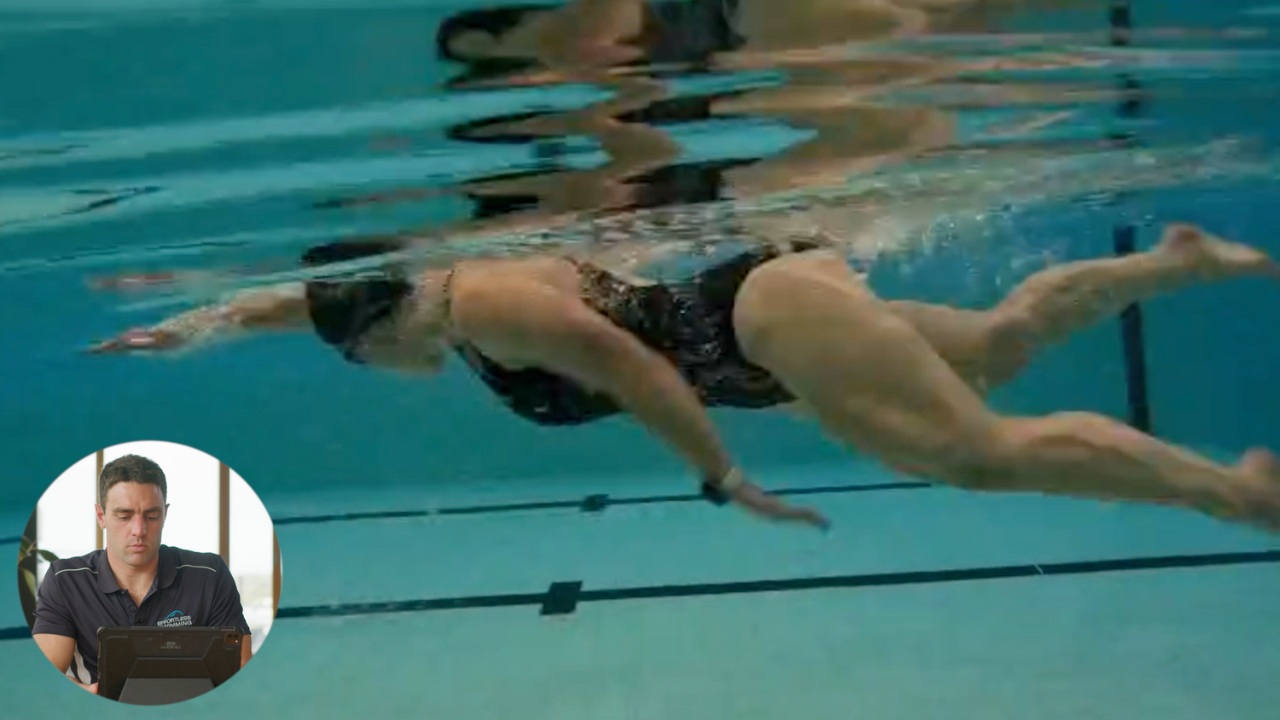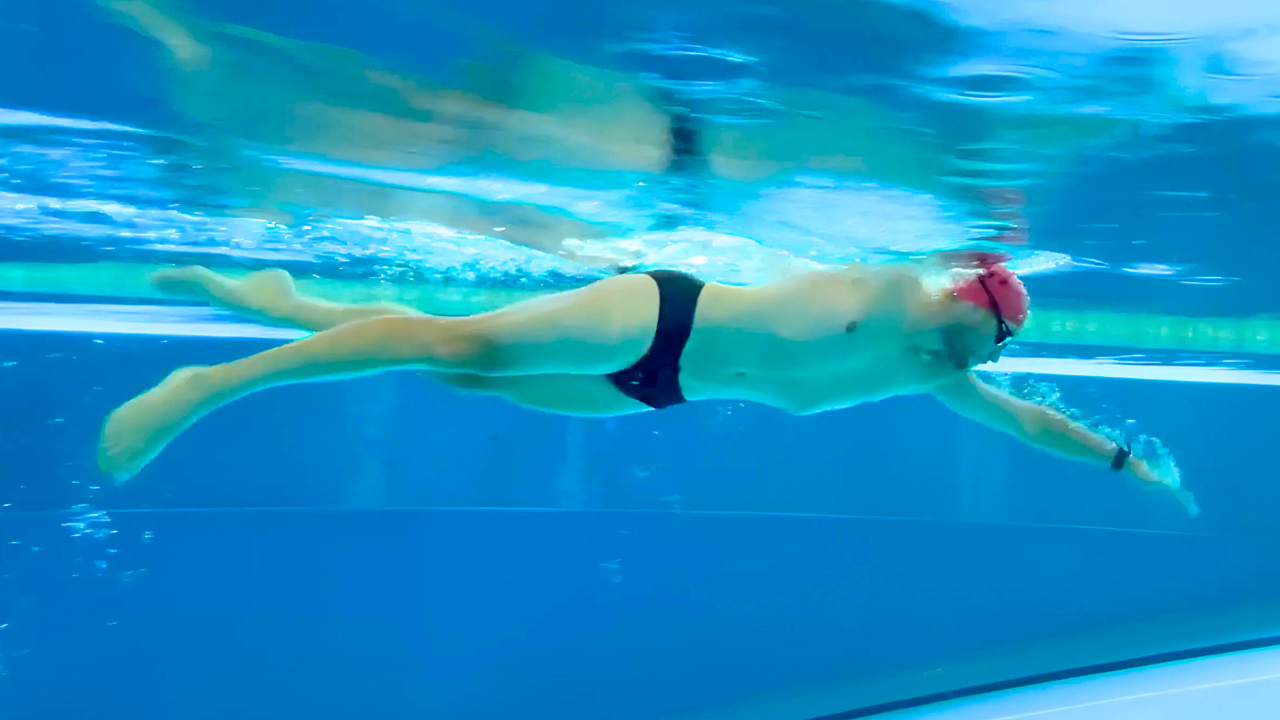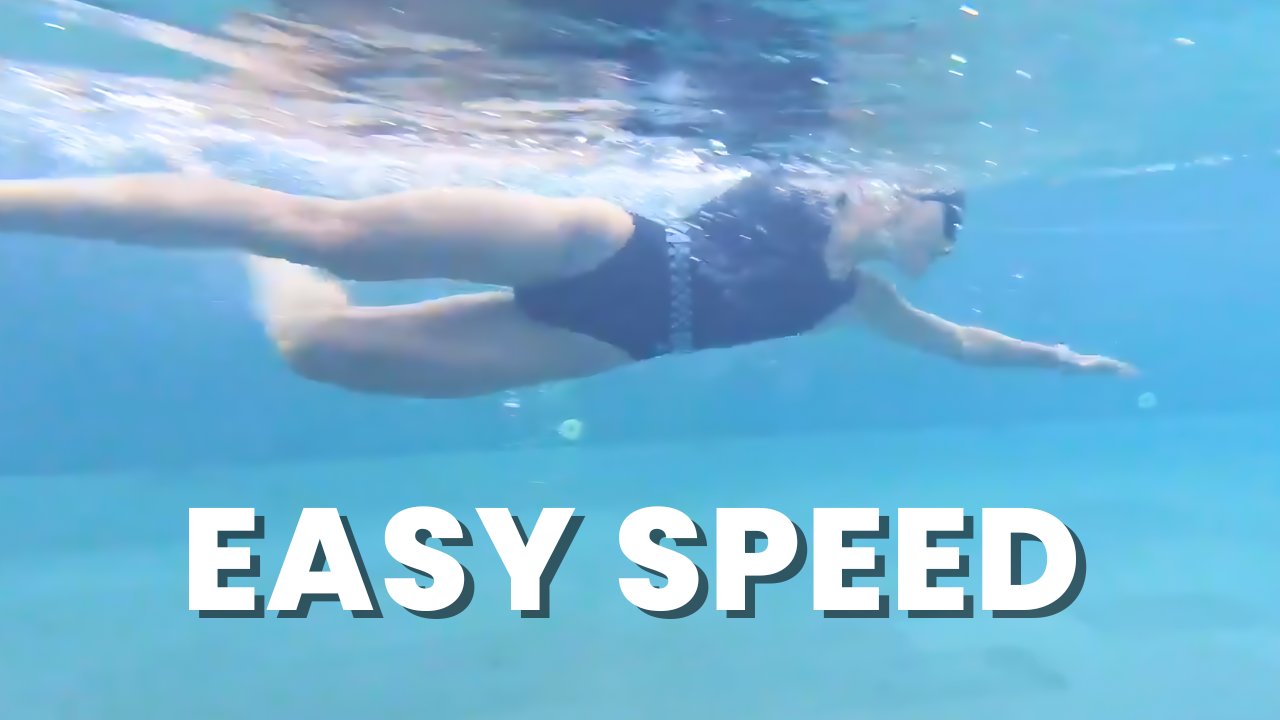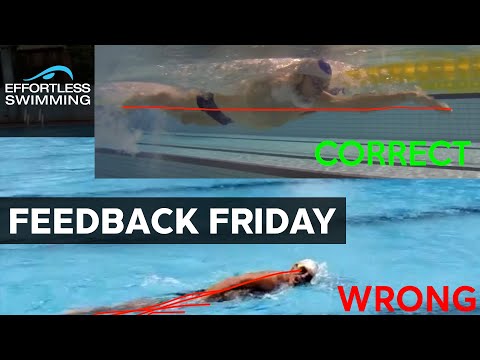If you’ve been trying to replicate some of Dan Smith’s technique in your own swimming, there are some changes you might want to make if you swim open water.
Transcription:
You might’ve sent out a video recently where we analyze Dan Smith’s stroke when he’s swimming that 110, 100. And he’s looking very, very comfortable. And when we analyze that strike, there’s a lot of things that most athletes can take away to improve their own swimming. But you might find that when you’re trying to pick up the pace, and particularly if you’re in open water swimming or triathlete, you might need to make some real variations from that sort of style of swimming. Because if I was to try and swim with that technique in my open water swims, and I was looking to hold a good pace there, for me it wouldn’t work. And the example I’d like to use here is, this is me swimming two years ago in Thailand at our Hell Week Swim Camp. And here I’m just swimming at a very comfortable pace, looking to have a really good technique and just get all those particular things right. So that I can hold really comfortably.
But it’s not how I’m going to race. If I was going to pick up the pace a little bit, the stroke would look a little bit more like this where the rating’s up, it’s not as pretty. The entry is a little bit more assertive there, and it doesn’t look as smooth. But that’s going to be quicker, but I can still hold that fairly comfortably. Now, still, that’s not how I would race if I was looking to do any events that are 3.8K’s or less. It would be a little bit more like this style if we’re looking from above. Where you can see the recovery’s quite a bit quicker. The entry, again, is a bit more assertive. And the recovery is also a bit more uneven. And by that I mean the left arm, as you can see here, is coming over a little bit higher and the right arm’s coming around a little bit wider. And I’m rotating a bit more to my breathing side.
That’s how I’d be when I’m in a wetsuit and I’m racing any open water swims that are about 3.8K or less. So if I was to try and hold, say this type of technique with that sort of rating, I’d be struggling to hold about a 120 to 125 pace. With this, I could hold about, probably about a 115 for a Half Ironman in terms of the pace with the swim. But this here, this is roughly what I can hold about a 109 pace in a Half Ironman swim. So it’s those changes through the stroke that you may need to make when you’re going open water and when you’re racing and picking up your speed. It’s those changes that you need to allow to come into your stroke. So there’s no point trying to hold this perfect technique that looks great, but it ends up being slower.
So the point that I’m trying to get across here is, if you are trying to replicate Dan’s stroke at all speeds within your swimming, you might be limiting yourself. And if you are doing open water swimming then that stroke, for a lot of people, doesn’t work, isn’t the best option for them. Especially if they’re doing anything that’s like a sprint distance triathlon or an Olympic distance triathlon all the way out to sometimes your full distance Ironman swimming. So it really just depends on what you’re training for. So yes, certainly good to have great technique work and all those things, and at anything that’s like a seven of 10 or easier, that style can work really well. But when you’re looking to pick up the pace a bit, it might need to change from there. And obviously it depends on what your goals are.
If you are really just wanting to swim with great technique and enjoy your swimming, and you’re not looking to push the pace and improve your swim speed for racing, stick with whatever you enjoy and what feels best for you. But if you are racing triathlon and open water swimming, some changes like this may be what you need to do. Now a few months ago what I did for members in our video membership, I recorded a presentation which was basically talking about, if you’re doing a triathlon, what changes may you need to make in your stroke. Now one of those things that I talked about was an uneven stroke. And so what we mean by an uneven stroke is the left arm here for me comes over a bit higher, and the right one comes over a bit wider. That’s part of an uneven stroke.
One of the other things can be on one side you might have a slightly wider catch and pull, where the other side might be a little bit closer into the center. Now I’m going to play part of this presentation where I’m talking about this part of the stroke, and you might find that this helps you. And then after that, I’ll show you a couple of other changes that you may want to make to your stroke based on if you’re doing a triathlon. So let’s have a look at that part of the presentation.
Now, this is one of my favorite things, and probably one of the number one points I want you to take away is, uneven is okay. There’s a myth out there that the stroke needs to be symmetrical and to be even on both sides, and that is certainly not the case. It can actually work against you. So an uneven stroke can be far more economical and sustainable. And your rhythm can be easy to find when you rotate more to one side and breathe one side. Now, this can look like a straighter arm recovery on one side or a wider pull on one side than the other, or even a loping style or freestyle that’s longer on one side than the other in terms of the stroke length and the time spent on that side.
So you’ll actually see this with so many of those good triathlon swimmers, is they’re really one side focused or one side bias. And if you’re not currently doing it, I encourage you to just try it when you’re doing some race pace efforts. Because if you can get into this rhythm where you might rotate that a little bit more to the one side, you might obviously recover that a little bit higher on one side, it can work really, really well for you. Because it’s just an easy way to swim, especially if you’re doing breathing every two strokes there. So I encourage you to try it if you have always focused on or tried to have this even and symmetrical stroke.
So yes, there are certainly some swimmers that do have this even and symmetrical stroke, particularly some pool swimmers who are doing hundreds or two hundred. Yeah, some of them have some very even strokes, and there’s obviously nothing wrong with that. But getting into the distance you’ll find that a lot of them have an uneven stroke. And probably one of the best examples of that is someone who we’ve looked at in a lot of these membership training videos is Gregorio Paltrinieri, who won the 1500 at the Rio Olympics. He has a very uneven strike. He’s certainly one side focused. He’s got a different or a wider catch on one side. And he’s got a stroke somewhat similar to that, so uneven is certainly okay.
Now the next thing is your breathing will set your rhythm. And what we mean by that is, if you are breathing every two strokes in your races that might be best for you, but you typically want to try and stick with the same type of breathing pattern through most of your race. Now if you do prefer to breathe every second stroke to your right hand side for 100 meters, then swept to the left hand side and breathe every two, that’s fine. Or even if it’s like a two, two, three, two, two, three, a similar pattern can be a very good thing to settle into because that’s going to set your rhythm. And if you’re doing any endurance swimming, any long distance swimming, then it really is something that we want to find is that rhythm because it’s all about managing and conserving your energy.
And the best way to do that is to settle into a rhythm that will work best for you and allow you to basically keep the effort down while keeping the speed up. And so for me, it’s breathing every second stroke, because then I get enough oxygen, get enough air in. And for me, I find I can just get into a rhythm that I can just feel and just sit in that rhythm the whole time. And then I don’t need to think about too much else just apart from managing my effort and output there. So I’m going to play that part of the presentation just talking about breathing, setting your rhythm.
And your breathing will set your rhythm. So your breathing pattern’s like the pendulum, you can set your timing and rhythm to. So most age group triathletes are naturally better breathing every two strokes to the same side with one straight arm recovery. So you want to pick your breathing pattern and stick to it in a race. And it can be every two strokes, every third, or even a patter like two, two, four. And you want to practice this same breathing pattern in training when you’re swimming at or close to race pace, you get more air this way too. So you get to breathe more often, you get to take more oxygen in and that is going to help you longterm.
And bilateral breathing is not required in a race. I like for some of us to be able to do it, and I know coaches like Brett Sutton who’s coached some of the top Ironman triathletes in the world, he doesn’t teach them bilateral breathing at all. But I like for the swimmers that I coach to be able to do it. So in your easy or recovery parts of your session, it’s good to do some breathing to the other side. And I like 30-40% of these parts of your sessions to be breathing to the opposite side. And it doesn’t need to be every third stroke, it can be one lap to one side and then the next lap to the other. So there are hard and fast rules around how you should do it. But it is good a good skill to have if you ever require in a race. If there’s chop if you do need to breathe the opposite side for any reason.
But in a race, do not be afraid to breathe to just the one side. And when you are training in your efforts, when you’re doing those efforts, it is okay to breathe just to that one side. So that’s what I tend to like to aim for. Now the video below, this is Dan Smith who’s a 200 freestyle, he’s not a triathlete. But you can see in the faster efforts that he was doing before he breathes every two strokes, and he’s going to stick with that for the entire race. He’s going to breathe every two. And he gets this very, very good rhythm through the stroke when he sticks with that breathing every two.
So once you’ve chosen what you want to do, stick with it and you will find that is that pendulum that you can just set yourself to. And you’ll find when you’re really in the zone when you’re in flow, you’re able to just continue to just sit in this zone and you won’t even be thinking much about it. You’ll be hearing, you’ll be feeling your breathing, you’ll be hearing how the water is moving around you and it’s going to feel a little bit like a dance once you get into that flow.
And that’s what we want to get to when we are racing. And even in some of those sets where you’re putting in quite a bit of effort and quite a bit of work, we want to get into that flow state where you’re not really thinking, you’re just, it’s almost like you’re outside.
If we have a look at a hip driven strike, what we’re talking about there is the rotation is really driven from the hips. That’s where it starts. And with that hip driven rotation, that small movement of your rotation through the hips can be very powerful. And so with that small movement, we can be very powerful without having to apply a lot of effort and power. Much easier than trying to get a lot of power and propulsion from just the arms and just the legs. But if we’re keeping our hips flat and we don’t get to connect everything up, it’s very hard work.
So in order to have a hip driven stroke, we want to keep the rotation to 30 to 40 degrees, somewhere in that range with the hips as you can see through here. And we also want to make it feel like you’re almost on hydraulics with your hips. It’s like side to side going left to right with your rotation. So if you imagine that the hips are on hydraulics, fairly controlled and even through it, it’s not like we’re rushing side to side and it’s slipping out. We want to be pretty controlled with that hip rotation. But a real key to getting that hip driven stroke is making sure that we swim imploded. Now the difference there is with an imploded stroke, everything’s going to be brought into the center. The comparison there is if you think of something exploding, everything’s moving out away from the center.
When you think of something imploded, it means everything’s brought into the center. So if you tuck your stomach in, suck your tummy in, bring your belly button into your spine, engage your glutes, squeeze your bum cheeks together lightly and feel like your inner thighs and your knees are coming together just a bit, not completely, but coming together a little bit. That brings everything in, and from that very central place, you can then get great rotation and connection through your hips and through the rest of the body. Now what I sometimes say when swimmers who join the membership, they’ll send me a video of their stroke. I mean, if we look from above, that bird’s eye view, if I see that their inner thighs and their knees are a long way apart, very little chance that they’ve got good connection through their core and through their hips.
Now the next thing is it should be hip driven. So the efforts shouldn’t be coming from just your arms or just your legs alone, it should come from the entire body. And it originates, it all starts from the hips. So if you think of a baseball player pitching a ball, he’s not going to stand there flat with his hips and his shoulders. He’s not going to be able to pitch the ball very fast if he’s just using his arms only to throw. He opens up through his hips and he lengthens through the body all the way through to the shoulder and to the arm. And it’s the cross connection that you get through the trunk that allows you to use minimal energy but for a much higher output than if you were swing flat. So it’s called the serape effect, and you will have seen this in one of our videos a couple of weeks ago where we talk about the cross connection through the body.
Where when you lengthen through your trunk and your upper body the muscles lengthen. And then when they go to shorten, you get this snap-back effect. Where you basically get all these muscles working together to give you quite a bit of output, quite a bit of power in that movement without putting in much energy or effort. And in swimming, it starts when the opposite hip is raised. And I’ll show you here, this is Josh Amberger down on the bottom here. So it starts when the opposite hip is raised, while your opposite arm… Sorry, while your other arm is outstretched.
So you can see here with Josh as he’s reaching forward with let’s say his right arm. So right there that left hip is raised. And he gets this stretching, this lengthening through the muscles through the trunk. And then when he starts to go through the catch and the pull, and that hip starts rotating back to the other side, it’s that shortening of the muscles that you get this snap-back effect. And I had a lot of comments in one of the videos I posted with Josh where he doesn’t fit the criteria of a classic really beautiful swimmer.
He has a really good rhythm and he has a really good power phase in the stroke. And he’s able to sort of do all these things that we’re talking about in today’s webinar. He’s able to do pretty much all of them together. So while it doesn’t look fast, it doesn’t look pretty, he is the fastest swimmer in Ironman for a reason. So when people were looking at the video, they were looking purely at the, I guess, the visual aspect of it and not appreciating the things that he does right. When I look at that I’m thinking, well, okay, if he’s the fastest swimmer in Ironman, what can we learn from looking at him if he doesn’t necessarily get your classic high elbow catch? He has a bit of crossover. We don’t obviously want to aim towards that, but there’s a lot of things he could change there.
But what are those things that he’s doing well that we can learn from? And he is really, really good at this hip driven technique. He gets this nice. He’s fairly even with his rotation, he gets this nice rotation through the hips and he gets this good lengthening through his reach phase, and he times it very, very well with his kick. So it should be hip driven, and that way you can have a much higher output for the actual effort that you are putting in.
If you would like to get the rest of this presentation, it’s inside the Effortless Swimming video membership, which I’ll provide a link to below. And there are quite a few other points that are important to get if you want to be a good triathlete or good swimmer in triathlon or in the open water. So I’ll provide that link below. And help support the channel, it helps me make videos like this. And if you’d like the real in-depth stuff where we’ve got all of our drills, all of our technique videos in one place where you know exactly what it is you need to work on, then check out the Effortless Swimming video membership. Thanks very much for watching. Hit the like and subscribe that helps us reach more people. And I’ll see you next week with another video.









